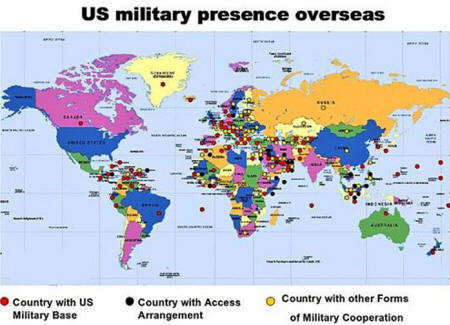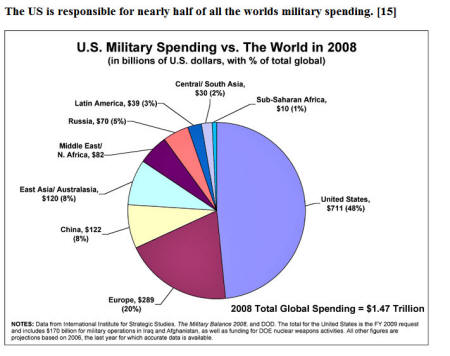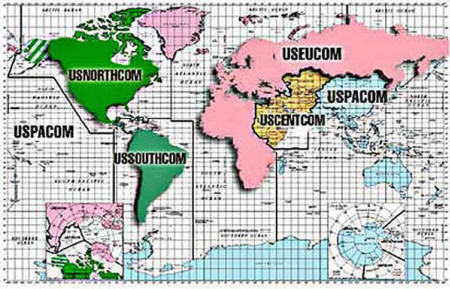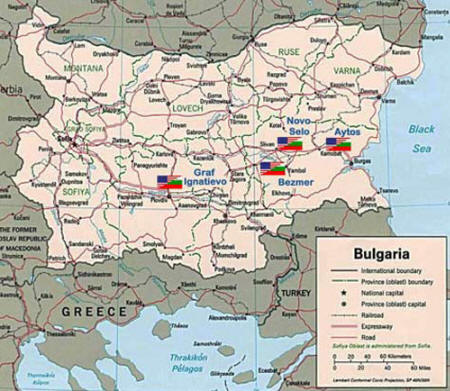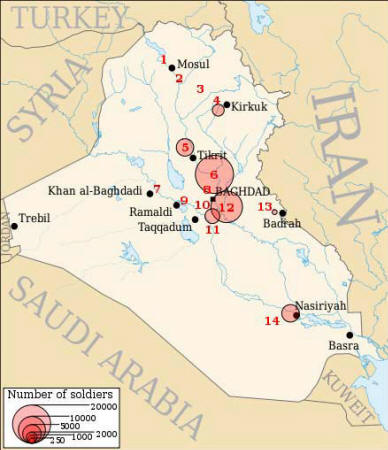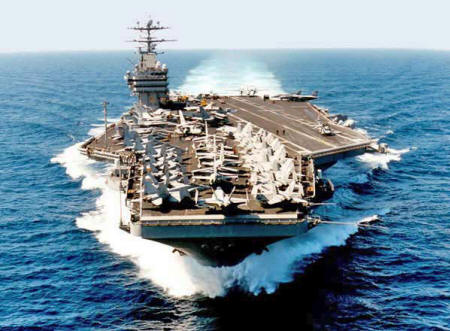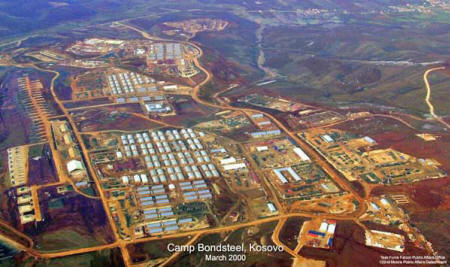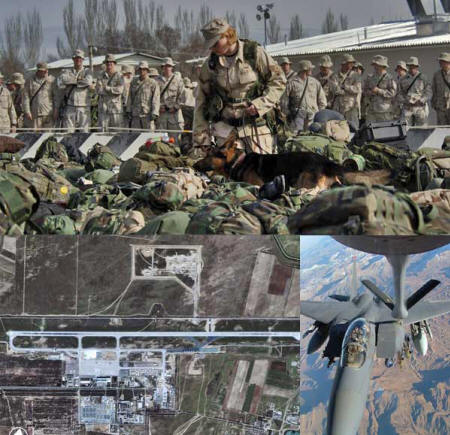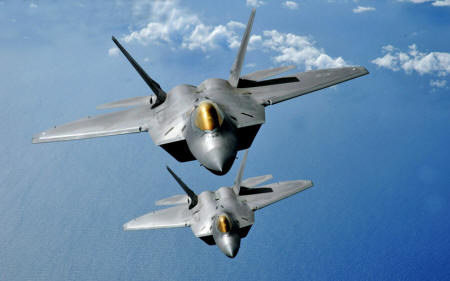|
|
|
|
1945-1970 |
1971-1992 |
1993-2002 |
2003-2005 |
|---|---|---|---|---|
|
SOFA/ACSA/MLSA [S/A/M] total treaties in force 129 |
23 |
24 |
62 |
20 |
|
Overseas military Deployment (yearly average) |
752,686 |
462-249 |
212,277 |
389,026 |
|
Overseas Bases (average)(582-1139) |
886 |
830 |
800 |
769 |
Two things are noteworthy from Table 1:
the reduction of US overseas military deployments during 1993-2002
the closure of some of its bases were offset by the increased access due to the S/A/M treaties negotiated during that same period
More of these access and status of forces agreements or treaties are being negotiated by the US with other host or potential host countries.
The number of troops stationed overseas has been reduced by more frequent but shorter deployments of troops. Furthermore, advances in transportation, communications and military technology have maintained the productivity and effectiveness of overseas bases despite the relative reduction in numbers.
The relative increase in troop deployments in 2003-2005 is due to the nearly 150,000 US troops in the Middle East that are currently engaged in Operation Enduring Freedom in Afghanistan, and Operation Iraqi Freedom in Iraq.
The massive introduction of US troops into the Middle East that started during the 1991 Gulf War and the continuing deployment of US troops for the Iraq and Afghanistan occupation spawned new bases in these countries as well as those nearby.
This is in line with the Project for the New American Century in which the personnel strength was to be restored to levels anticipated in the "Base Force" outlined by the Bush Administration.
Repositioning To Meet "21st Century" Realities
In the same document, the need to reposition US forces to respond to "21st Century" strategic realities was enunciated by shifting permanently-based forces to Southeast Europe and Southeast Asia reflecting strategic concerns of the US in these areas.
Geographically, Europe remains the largest concentration of main operating bases outside the United States mainland. In 2004, European bases hosted over 116,000 troops, their 125,000 dependents, and 45,000 support personnel, plus their dependents.
The key countries are Germany with air and ground troops, the UK with air and naval personnel, Italy with air and naval bases and Turkey with air bases. US documents indicate a planned force reduction to 60,000 and a shift to lighter ground forces and adding Romanian and Bulgarian bases to US force posture (in 2005, US troops in the European Command numbered around 98,000).
NEW US
BASES IN BULGARIA IN TERRITORY ONCE
CONTROLLED BY THE OLD SOVIET UNION
In Asia, there are over 67,000 overseas troops in around 225 bases in Japan, South Korea and Indonesia.
There are forces in Thailand, access agreements with Singapore and military exercises in actual combat zones in the southern Philippines. Guam remains the most important place outside the US mainland where new air, naval and ground facilities are being slated to be added.
Guam is also set to receive redeployments of 7,000 Marines from Japan (Okinawa) while South Korea also faces significant redeployments and consolidations.
Using China as a pretext, US, as well as Taiwanese, military officials are pushing for a theatre missile defense (TMD) system installation in Taiwan as part of the US dual encirclement and engagement policy towards China. The absence of a US military base or deployment in Taiwan does not deter large arms sales to Taiwan.
US arms sales to Taiwan have been significant at $US71 billion for 1999-2005 alone, third after Japan and South Korea. In his confirmation hearing to become Secretary of Defense, Robert Gates said:
"We should maintain our capabilities to resist China's use of force or coercion against Taiwan and assist Taipei in maintaining its self-defense".
Regular defense dialogues between defense officials of Taiwan and the US are also held regularly.
In the Middle East, bases in Bahrain, Kuwait, Qatar, the United Arab Emirates, Yemen and Oman in the south; in Lebanon, and Turkey in the north; and Pakistan and Afghanistan in the east form a partial ring around oil rich countries such as Saudi Arabia and Iraq and the critical sea lanes in the Persian Gulf.
The Middle East has the largest number of US troop deployments with approximately 218,000 (but frequently changing).
There are a number of bases in Iraq in the ongoing effort to conduct "stability operations" that serve as bases of power projection against Iran and Syria. There are also new bases in Afghanistan, which flank western China and provide control and protection of pipelines from the Caspian Sea basin through Central Asia.
This economic aspect underlies the increasing importance of the bases in Central Asia in Uzbekistan, Kyrgyzstan, Tajikistan and Pakistan where around 70% of the world's oil reserves and natural gas lie.
In Iraq in 2005, the US military maintained 106 forward operating bases with 14 "enduring" bases. There were around 40 large bases (2005) and 110 small to medium bases in Iraq.
The reduction of base infrastructure brought the total number of bases down to around 75 in 2006.
Map of the
14 "ENDURING BASES" (i.e., permanent
bases) US military bases in Iraq:
|
These bases will remain after the US supposedly pulls out what is described as its "combat forces." The forces that will remain on these bases will be re-designated as "military assistance" forces and / or "logistics personnel." And this doesn't count the thousands of other "mercenary forces." Indeed, the US is slated to double its mercenary forces in Iraq after the so-called 2011 Military Pullout date.
In 2006, US troop deployment at sea was about 127,000. Sea-based forces include those aboard ships such as aircraft carriers, destroyers and submarines.
These carriers serve as moving centers of projected strength through their strike capabilities.
USS GEORGE WASHINGTON
There are ships the USA has in their military arsenal and then THERE ARE SHIPS THE USA HAS IN THEIR MILITARY FLEET, the kind that no other nation on earth possesses. [The carriers in the French, British, Italian, Russian, etc. fleets are app. 35,000 tons apiece. The carriers the US possesses approach 100,000 tons - this is why they are referred as SUPER-CARRIERS; the US has 12 of these on active duty, and many others in "reserve."]
You don't have to look no further than the USS George Washington; which is in a class of its own. Able to carry more than 6,000 sailors, crewmen, pilots, and other military personnel is just the starting point. This super-carrier can also hold up to 70 airplanes and is routinely carrying about 4 million pounds of bombs and other explosives on board; which can be delivered in a variety of ways. Not to mention all of the other military ships and under water submarines, that would be traveling along the side the USS George Washington. This super-carrier is a permanent fixture in the Asian-Pacific Ocean and is normally docked on the shores of Japan.
These ships can also contain sea-launched cruise missiles such as the Tomahawk which are part of the existing triad of strategic nuclear force projection.
In Asia, the US Third Fleet covers the Eastern and Central Pacific while the Seventh Fleet based at Yokosuka covers the length of the Western Pacific to the Indian Ocean.
There are around 35 submarines (nine SSBN, two SSGN, 24 SSN) deployed in the region, some of which are capable of launching submarine-launched Trident and Poseidon ballistic missiles. SSBN - Ship Submersible Ballistic missile Nuclear powered. SSGN - Ship Submersible Guided missile Nuclear powered. SSN - Ship Submersible Nuclear powered.
Through the US Navy Sea Power 21 and Marine Corps Strategy 21, the US Navy introduces new concepts of maritime pre-positioning: high speed sea lift, new amphibious capabilities of Marine Corps and training for littoral warfare in Western Pacific.
It has three prongs according to Sea Power 21:
Sea Strike - Projecting Precise and Persistent Offensive Power. Expanded power projection that employs networked sensors, combat systems, and warriors to amplify the offensive impact of sea based forces;
Sea Shield - Projecting Global Defensive Assurance. Provided by extended homeland defense, sustained access to littoral [coastal] zones and the projection of defensive power deep over land;
Sea Basing - Projecting Joint Operational Independence and support for joint forces provided by networked mobile, and secure sovereign platforms operating in maritime domain.
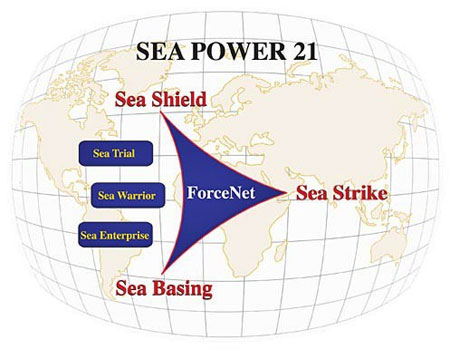
The US Quadrennial Defense Review Report in 2001 called for an increased naval presence in the Pacific as well as pre-positioned equipment and contingency basing assets in the Persian Gulf and Indian Ocean.
These are in four forward regions:
Europe
Northeast Asia
East Asian Littoral regions
Middle East-Southwest Asia
Overseas base structures and facilities are now classified into three types: Main Operating Bases (MOB), Forward Operating Locations (FOL), and Cooperative Security Locations (CSL).
Main operating bases (MOB) are US bases with permanently stationed forces with their families. Rearrangement of forces in European and Asian MOBs such as Ramstein (Germany) will result in relative force reductions: 65,000 troops are planned to be removed from Europe and one brigade from South Korea.
These forces are to be deployed to other locations where they are needed. Forward operating bases or locations (FOB/FOL) include the sprawling Camp Bondsteel in Kosovo and Manas in Kyrgyzstan as well as the vast Grafenwoehr/Vilseck/Hohenfels complex in Germany.
These FOL are bases with pre-positioned equipment and small military support groups.
Camp BONDSTEEL
from where the US controls ALL of the Balkans.
Manas Air Base in Kyrgyzstan
from where the US controls the airspace over Central Asia
and most of the nations south of present-day Russia
who were member-states of the old Soviet Union.
Cooperative security locations or CSLs are facilities occupied only for training, exercises and other military interactions (e.g., rest and recreation activities) with regional partner countries.
Examples of these locations are those where joint Balikatan (Shoulder to Shoulder) exercises in the Philippines and Cobra Gold in Thailand are usually held. New CSLs are being developed in Africa, South Central Asia and East Asia that do not require permanent basing structures such as the carrier pier in Singapore.
Recent US military aggression in Iraq, Afghanistan and in the Balkans has brought about new military bases and control over oil resources. But over the long term the US aims to increase its reach while keeping the profile of its intervention small.
This is evident in the problems highlighted by the report of the 2006 Iraq Study Group.
This is but a recipe for neo-colonialism:
intervention or direct aggression in a country, rapid stabilization of the state or area using the force required
a shift to a minimum US military presence as rapidly as possible
rapid creation and training of effective local security and intelligence forces
reduction of forces to a required minimum to encourage "sustained reform".
However,
"...the more that local government and security forces are seen as proxies or subordinates of the US, the more difficult it will be for them to establish legitimacy".
The Role of US Bases and Their Impact on People's Lives and Environment
"The presence of American forces overseas is one of the most profound symbols of the US commitments to allies and friends.
Through our willingness to use force in our own defense and in defense of others, the United States demonstrates its resolve to maintain a balance of power that favors freedom.
To contend with uncertainty and to meet the many security challenges we face, the United States will require bases and stations within and beyond Western Europe and Northeast Asia, as well as temporary access arrangements for the long-distance deployment of US forces".
George Bush, National Security Strategy, 2002
US overseas military bases reflect the need for the United States to project a visible and psychological presence and commitment to a country or region.
US bases are stark reminders and real sources of control over a nation without necessitating formal political control over its territorial sovereignty. It can be likened to a loaded gun pointed at the government and peoples of its host country.
Its mere presence intimidates and gives coercive power for the US to gain concessions from the host and allows it to interfere, in most cases with impunity, in internal affairs, commit crimes and violence on local people, and wreak grave social costs and environmental destruction.
US military bases serve as surveillance and data centers.
These bases, such as those within the NSA ECHELON network, provide intelligence gathering functions for the US. The data collected from these activities are not necessarily limited to those with military use but also extends to economic surveillance as well. In terms of surveillance and data centers - we see this as a vital function taken on by host countries like the Philippines (until the US bases were booted out in 1992 after almost a century of military occupation).
Currently, major US military facilities in Japan and Okinawa, in Guam and in Australia take on this function of surveillance and data gathering.
Which makes me ask the question - how much of the surveillance and data gathering work done at Waihopai as well as at Tangimoana contribute to this global surveillance and data gathering work for the United States?
While they are technically New Zealand facilities, as the New Zealand and the United States governments have consistently claimed, one can't help but ask the question how much of their work contributes to US capability and military strength in its global posturing.
These are new issues I have encountered on my speaking tour of New Zealand with the Anti-Bases Campaign.
It would be very interesting and useful to know the truth behind these facilities in New Zealand and how they contribute to the United States' wars of aggression in the Middle East and its expanding military presence in Asia and the Pacific.
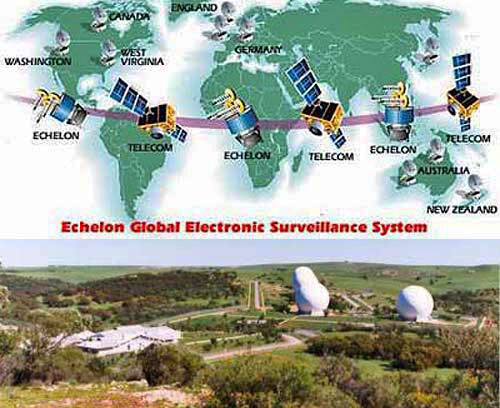
US Echelon base in Waihopai, New Zealand;
US Echelon base in Geraldton, Western Australia.
US bases also serve as locations for pre-positioning supplies.
Even before September 11, 2001, in the "Project for a New American Century" and in the 2001 Quadrennial Defense Review (QDR2001), the Pentagon was reconfiguring its forces to become smaller, more flexible, and better able to respond to sudden events, thus necessitating pre-positioned supplies and war materiel.
In situations lacking established bases, the US has entered into more than 80 bilateral agreements since 1992 to provide it with a range of access and status of forces agreements that it can call on depending on the need of the situation.
In addition, through its use of advanced military technology, these agreements allow the US to apply greater amounts of military force over greater distances in shorter periods of time.
The 2004 National Military Strategy outlines how expanded bases can increase the ability of the US military to rapidly deploy, employ, sustain and redeploy capabilities in geographically separated and environmentally diverse regions.
These bases serve as launch pads for the pre-emptive strikes including nuclear attack, "peace-enforcement" and "constabulary" functions that the QDR 2001 has called for.
US bases also serve as sites for training & munitions testing. US Navy weapons testing was carried out in Vieques, Puerto Rico, for over 60 years (ended in 2003) and included testing for operations in the Persian Gulf region. Vieques also hosted a US Navy listening post for underwater tracking of submarines and an electronic warfare range for testing new weapons systems.
Crow Valley in Clark Air Base in the Philippines was used as a practice bombing site before the removal of the bases in 1992.
US military presence in bases or in exercises and training is usually seen as a precursor to intervention and war. In East Africa, where around 30 US National Guard soldiers from Guam have been training Ethiopian commandos in supposed "anti-terrorism" exercises, tensions flared up over a long standing border dispute with Somalia. It is not an accident that the US has been conducting this training near the border and that the Islamic Somali leadership has resisted this presence.
US bases are bases for counter-insurgency in the host country and surrounding regions.
So-called "stability operations" are venues for political and military intervention in domestic affairs and excuses for US military presence. In performing "peace-enforcement" and "constabulary" functions, such as that in Iraq, the US has shown its willingness to directly intervene to allow US companies and firms free rein in the plunder of Iraq's resources.
In Mindanao, southern Philippines, the US military has provided training, war materiel, logistic support and "advice" to Special Forces of the Armed Forces of the Philippines as part of its War on Terror.
The forward positioning of US bases serves as forward tripwires, guaranteeing timely and rapid US intervention in a crisis situation as in the case of the function of US bases in the Korean peninsula.
That the US calls the Philippines its "second front in the War on Terror" is not an accident.
The US, through its periodic and overlapping joint exercises with the Philippine military, is able to strengthen its position in the Philippines for the purpose of ensuring its control over oil resources in Southeast Asia.
US bases serve as launching pads for US aggression.
Clark Air Force Base, Subic Naval Base and other military installations in the Philippines were used for launching wars of intervention from the 1950s until 1991. Clark was used to send bombing missions during the Korean War of 1950-1953 and in the bombing of Sumatra during a rebellion by the Indonesian army in 1958.
Clark also figured in the deployment of US forces in the area of the Taiwan Strait islands of Quemoy and Matsu, which were militarily disputed by Taiwan and China.
From 1955-1986, US military bases in the Philippines were used frequently for bombing missions in the wars, the training and deployment of US troops, and as communication links as well as for rest and recreation of tired US servicemen.
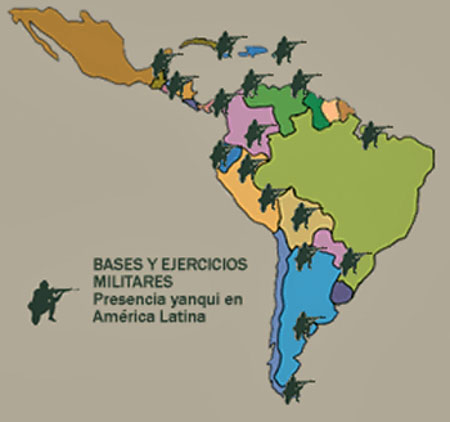
Map showing US bases in Latin America,
or bases that it can access.
US bases serve to secure sea-lanes, oil pipelines and other economic interests of the US.
To provide energy security, the US surrounds oil rich countries such as Saudi Arabia, Iraq and Kuwait with a US military presence through direct basing or access agreements in neighboring countries. In the guise of counter-narcotics to straddle Venezuela, Bolivia and other Latin American oil rich countries, the US launched Plan Colombia and other exercises. It has occupied Afghanistan to secure pipelines from Central Asia.
It has positioned itself in Singapore and has established a US base within a Philippine military base (Zamboanga), and consistently maintained US troops in the Philippines through military exercises to protect the sea lanes through which nearly 50% of world trade passes.
Military deployment under the US war on terrorism through direct basing and/or access agreements ensures continuing expansion of the US Empire and protection of its political and economic interests.
In terms of social cost of US military bases and presence, violation of national sovereignty and territorial integrity of the host country has the greatest impact. The arrival of US forces invariably involves some form of military intervention including outright aggression, occupation and colonization.
This is aggravated by the US policy and practice of shielding its troops from criminal prosecution under the host's judicial processes and system, oftentimes under the legal cover contained in access and status of forces agreements.
US Bases In The Asia Pacific Region
"The presence of 100,000 US military personnel is not arbitrary - it represents the formidable capabilities of the US Eighth Army and Seventh Air Force in Korea, III Marine Expeditionary Force and Fifth Air Force in Japan, and the US Seventh Fleet, all focused on shaping, responding and preparing as necessary to achieve security and stability in the region."
These forces in the Asia Pacific region are mainly in these positions:
Japanese bases which maintain, the US Fifth Air Force, including 18th Wing, 35th Fighter Wing and 374th Airlift Wing
the Navy Seventh Fleet, including USS Kitty Hawk Carrier Battle Group (which was replaced by the US nuclear aircraft carrier USS George Washington on September 25, 2008)
USS Belleau Wood Amphibious Ready Group
III Marine Expeditionary Force (MEF)
Ninth Theater Area Army Command (TAACOM)
First USA Special Forces Battalion
South Korea hosts the US Seventh Air Force, including the Eighth and the 51st Fighter Wings, and the Eighth Army, including the Second Infantry Division.
In addition to the forces above, visiting forces allow additional routine combined exercises and training, and ship visits. Changi Naval Station in Singapore accommodates US naval combatants and includes a pier which can accommodate US aircraft carriers.
Thailand is an important refueling and transit point for operations in the Indian Ocean and the Arabian Gulf. Australia has long provided key access to facilities for US unilateral and combined exercises. The US makes 60-80 port calls per year to Hong Kong for minor maintenance and repair of transiting ships.
Access agreements have become increasingly important as US forces and bases have been reconfigured and plans to downsize its forces in the region are underway.
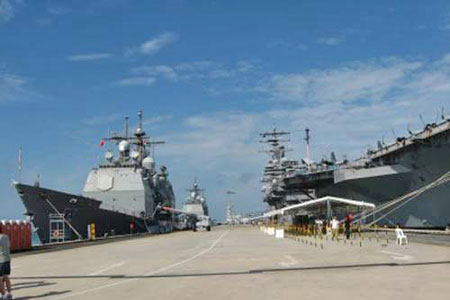
USS Ronald Reagan and other
US warships
at Changi Naval Station in Singapore
In South Korea, Japan, the Philippines, Malaysia, Singapore, Thailand, Indonesia, and Australia, access to key host nation facilities, ports and airfields are critical to the US security objectives in the Asia-Pacific.
Access agreements such as Mutual Logistics Support Agreements and Acquisition Cross-Servicing Agreements make available the use of host nation resources to support day-to-day and future operational requirements. They also enable joint training and exercises, "constabulary" operations, humanitarian and disaster relief operations.
These provide the US access to basing and infrastructure necessary for its force projection without the need for a permanent presence.
The US offers these countries money to upgrade and maintain infrastructure, bases and airfields. In addition, the US spent $US265.7 million for 2001-2004 in training 4,000 Indonesian, 1,200 Filipino, and 700 Thai police.
Taiwan is also one of the region's largest weapons buyers from the US while the Philippines has been its largest recipient of military aid.
Under its global War on Terror, the Bush Administration deployed over 1,200 troops, including 150 US Special Forces, to the southern Philippines to advise the Philippine military in their pursuit of the Abu Sayyaf Group.
It also increased intelligence sharing operations, restarted military to military relations with Indonesia and provided or requested from the US Congress over $US1 billion in aid to Indonesia and the Philippines.
Guam - The New Key Hub for Pacific Power Projection
There are important developments in the region that we need to keep a close watch on.
The Pacific island of Guam is being transformed into a key hub for American maritime power in the western Pacific. The strategic importance of Guam to Washington's long-term presence in East Asia was a point hammered home by US Defense Secretary Robert Gates in Singapore recently.
Gates' speech to the Shangri-La Dialogue, an annual gathering of Asian defense ministers and military chiefs, was his most complete exposition of future US defense strategy in the region since he took over from Donald Rumsfeld at the Pentagon in early 2007.
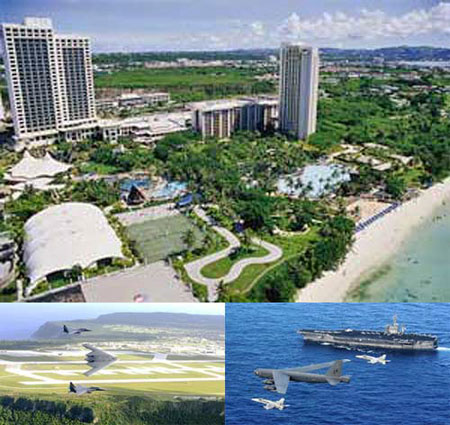
HEADQUARTERS FOR SUPER-BASE IN GUAM
ANDERSON AFB ON GUAM
USS NIMITZ OFF GUAM
US building a super-base on Pacific island of Guam
The US is building a super military base on the Pacific island of Guamto contain China's military build-up.
The expansion will include a dock for a nuclear-powered aircraft carrier, a missile defense system, live-fire training sites and the expansion
of the island's airbase.
It will be the largest investment in a military base in the western Pacific since the Second World War, and the biggest spend on naval infrastructure in decades.
Estimates suggest that the island's population will rise by almost 50 per cent from its current 173,000 at the peak of construction.
It will eventually house 19,000 Marines who will be relocated from the Japanese island of Okinawa, where the US force has become unpopular.
The US was not about to begin a long, slow, historic withdrawal from the region.
Instead the US Defense Secretary outlined the concept of the US as a 'resident power' in addition to its longstanding roles as an ally, partner, friend and routine offshore presence.
Critical to its long term focus as a resident power will be Guam, the site of the largest US military build-up in the Mariana Islands since World War II. As the Pentagon chief pointed out, sovereign US territory in the western Pacific stretches all the way from the Aleutian Islands to Guam.
For US defense planners aiming for a mobile, more flexible US global military posture across the globe, Guam is an ideal staging post. And for close allies of the US in the western Pacific, led by Japan and Australia, Guam promises to become a vital facility as it hosts exercises and trains with allied air and naval forces.
Secretary Gates also made a flying visit to Guam, 6, 000km west of Hawaii and 2, 000km southeast of Japan, to look at planned defense infrastructure. Acquired from Spain in 1898 following the Spanish-American War, Guam became a refueling station for the US Navy.
Guam has long been an important logistics base. Over the next six years the Pentagon will spend billions on a new port capable of berthing a nuclear powered aircraft carrier, and will build air bases, schools, hospitals and housing for US military personnel and their families.
Guam's Andersen Air Base will soon be home to a detachment of unmanned, long-range Global Hawk surveillance aircraft able to track Chinese warships and submarines emerging from their home ports into the Pacific Ocean or the South China Sea.
F-22 Raptor
The US Air Force's newest fighter, the F-22 Raptor, will also be periodically flying on exercises from the island.
By 2014 Guam will receive about 8, 000 US Marines who will transfer from their present base in Okinawa, the Japanese Government helping pay the $US10 billion-plus relocation costs. With a population of about 170,000 Guam is already home to 12,000 US military personnel and the heavy build-up promises to put further strain on local communities.
Its naval base hosts three attack submarines and the Air Force rotates its strategic bombers through Guam.
As the island's new facilities take shape in coming years, they will be increasingly multilateral in orientation, with training opportunities and possible pre-positioning of assets. Clearly, a message designed to convey a reassurance to the US's close allies in East Asia that talk of the gradual diminution of the US's military posture in the face of a renascent China was misplaced.
The Defense Secretary argues forcefully Washington's presence has been an essential element in assisting Asia's economic revival,
"opening doors, protecting and preserving common spaces on the high seas, in space and more and more in the cyber world".
"This presence has offered other nations the crucial element of choice and enabled their entry into a globalized international society," he said.
"As someone who has served seven US Presidents, I want to convey to you with confidence that any future US Administration's Asia security policy is going to be grounded in the fact that the United States remains a nation with strong and enduring interests in the region, interests that will endure no matter which political party occupies the White House next year".
Gates went on to say that any speculation in the region about the US losing interest in Asia struck him as,
"preposterous or disingenuous, or both".
He stressed US military ties with East Asia, even with its operations in Iraq and Afghanistan, were more constructive than at any time in US history.
New Spybase In Australia
In Australasia a very significant new initiative is the construction of a new top secret US military communications base in Western Australia.
Australian Defense Minister Joel Fitzgibbon revealed recently that work would begin in July or August of 2008 on a satellite ground station for the US Mobile Users Objective System, a new satellite communications system being deployed by the US Navy.
The new US defense facility will be located adjacent to the existing Australian satellite signals intelligence facility at Geraldton, Western Australia (the existing spy base is functionally equivalent to New Zealand's Waihopai station and both are key facilities in the US Echelon global intelligence system).
The base will be linked to a network of communications satellites that will provide frontline US military units with instant access to high grade intelligence and tactical information. Once operational, the new facility will automatically provide communications support for US military operations in Iraq and the Persian Gulf.
Indeed, it will also automatically provide communications support for US military operations in much of the Asia-Pacific region.

The Age has learned that the US is to build the base,
which follows three years of secret negotiations with Canberra.
The base will provide a crucial link for a new network of military satellites that will help America's ability to fight wars in the Middle East and Asia.
It is the first big US military installation to be built in Australia since the controversy surrounding the joint spy base at Pine Gap more than two decades ago.
It will provide a key link in the system that will carry orders and intelligence information to US and allied troops on operations in the world's hotspots.
Details of the deal emerged on the same day as the US finally told Australia it would not allow even its key allies, including Australia,
to buy its best fighter aircraft, the F-22 Raptor.
The base, about 370 kilometers north of Perth, will control two of five geostationary satellites - those with the highest priority parked over the Indian Ocean
to monitor the unstable Middle East.
Building may start within months.
Australian defense officials announced late in 2007 that they had finalized an agreement with the US Navy for the new satellite communications centre.
Mr Fitzgibbon's confirmation that construction would proceed came shortly after newly elected Prime Minister Kevin Rudd's withdrawal of the bulk of Australian combat troops from Iraq.
The new Geraldton facility will be the first major US defense base to be established in Australia since the construction in the 1960s of the Joint Defense Facility at Pine Gap in the Northern Territory and the now closed early warning satellite ground station at Nurrungar in South Australia.
It was also revealed that the US Navy had contracted with Boeing Australia to provide construction services for the new Geraldton base. Boeing Australia already provides operational support for the existing facility at Geraldton, another Australian signals intelligence facility at Shoal Bay near Darwin, the Australian Navy's communication station at North West Cape near Exmouth, and the Defense Communications Network facility at Deakin.
About 70 Australian contractors are working on the design of the new Geraldton building and up to 20 United States staff and 100 Australian contractors will be involved in the construction phase.
The ground station will comprise three buildings housing sophisticated electronic infrastructure, three 18m satellite dishes and two smaller antennas.
Once complete, the base will be fully automated and will require only call-out maintenance support. All costs will be carried by the US. Informal discussions on the possible location of the facility in Australia began in 2003. Australian Defense and the US Navy signed a classified memorandum of understanding setting out the governing arrangements for the station in November 2007.
The conclusion of a secret memorandum of understanding rather than a formal treaty means the agreement has not been reviewed by Federal Parliament's Joint Standing Committee on Treaties.
Mr Fitzgibbon has said the ground station will be operational by 2011.
There is also the new Hawaii Regional Security Operations Center complex at the US Naval Computer and Telecommunications Area Master Station Pacific. The $US318 Million, 250,000 square foot complex is the largest construction in Naval Engineering Facility Command and is scheduled for completion in late 2010.
The new facility will be used to gather and analyze intelligence from US interest areas, such as the Middle East and South East Asia, allowing high ranking officials to make better tactical decisions.
Because of the tremendous changes in communications technology over the past two decades, coupled with the disturbing social and political dynamics, newer and better ways to process intelligence are needed.
Through its military bases and access agreements, the US makes its presence felt in an ever-widening circle driven by its greed for resources and markets.
However, as attempts are made to expand this circle, the US faces the resistance and condemnation of oppressed people of the world who continue to develop solidarity to strengthen their continued call for peace and justice.
Nations have also stood firm in their assertion of sovereignty and independence against the US Empire's never ending greed for power and dominance.

